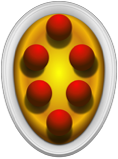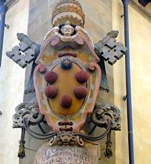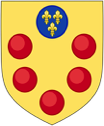
Page 5
Click monogram to return to home page
You will also find the Medici stemma in most Tuscan towns as they were under Medici rule. The palla (singular) at the top is picked out in blue paint. Two great Renaissance popes were Leone X Medici (1513–1521) and Clemente VI Medici (1523–1534). Therefore, any church, palazzo, or villa you see in Rome, as well as Florence and elsewhere with the Medici stemma attached, means that it was built or renovated during their cardinalate or papacy depending on hats, tassels, and keys!
Deciphering this family stemma is relatively straightforward: Always six balls or sphere, five red and one blue. The ball at the top is blue in color because it is the background color or the seal of the kings of France. Furthermore, the blue palla is inscribed with three golden lilies (fleurs-de-lis) that, again, represents the kings of France.
How is it that the kings of France’s crest here appears as transformed into a sphere and combined with the five other spheres? Memorizing the visual story is easy, but again curiosity digs deeper: it’s said that the French King Louis XI had a debt with the Medici family and in order to reduce his debts, he allowed the bank to use his symbol, giving the Medici bank more clout among the people and within Italy; after all, the blue ball and lilies signify royal ‘lineage’ and connections. It might also be noted Catherine de' Medici was the queen consort of Henry II (1547–59) and regent of France. Thus, by the mid-16th century the ‘lineage’ became legitimate.
Others say the balls had less exalted origins: some say they were pawnbrokers' coins or medicinal pills (or cupping glasses) that recalled the family's origins as doctors (medici) or apothecaries. Others say they are bezants, Byzantine coins.



=
Shield on the corner of Palazzo Arcivescovile, Florence
+